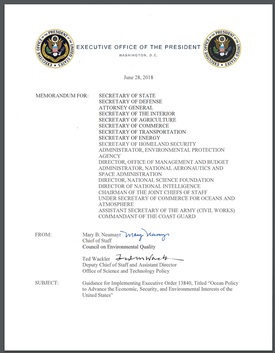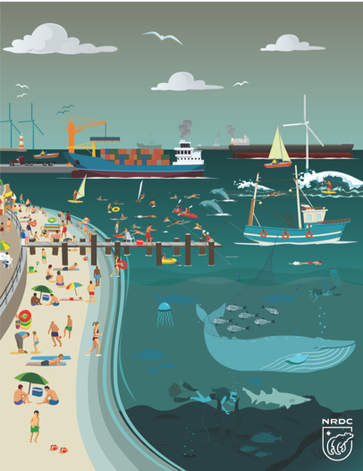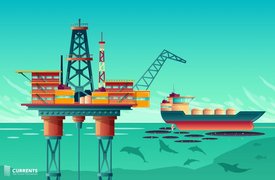|
Editor’s Note: In June 2018, U.S. President Donald Trump issued Executive Order 13840 Ocean Policy To Advance the Economic, Security, and Environmental Interests of the United States. This executive order formally revokes Executive Order 13547 Stewardship of the Ocean, Our Coasts, and the Great Lakes, issued in July 2010 by former U.S. President Barack Obama. MEAM interviewed Sarah Winter Whelan, director of the American Littoral Society's Ocean Policy Program and Healthy Oceans Coalition, about what these changes mean for ocean planning in the U.S., including existing regional ocean plans. MEAM: This new ocean policy will likely lead to big changes in how the U.S. federal government participates in regional ocean planning. What are your thoughts on what this means for the existing Northeast and Mid-Atlantic regional ocean plans?  Winter Whelan: The new Trump Policy on the ocean throws a curveball into current U.S. regional ocean planning efforts. The dismantling of the National Ocean Policy (NOP) for the Trump Policy is a serious shift in how our coastal regions can engage the federal government in shared ocean and coastal issues. I see three big issues at play relating to regional ocean planning: 1) the White House guidance memo on Trump’s new executive order makes it clear that the 2016-certified Northeast Regional Ocean Plan and Mid-Atlantic Regional Ocean Action Plan “are no longer controlling policy for Federal agencies” with the federal government no longer willing to engage on the previously-collaborative ecological work, 2) coastal states are in the driver’s seat on ocean policy and planning, and 3) the new policy makes it harder for tribal nations to engage in regional planning because the requirement that tribes, states, and federal agencies work together as co-planners on NOP regional planning bodies no longer exists. The NOP’s framework for ocean planning directed federal agencies to engage in planning if a region expressed interest in the process and to comply with any plans developed as a result. The Trump Policy strips that back and requires regions to rely on previously existing, state-run partnerships, called Regional Ocean Partnerships (ROPs), or create an entirely new structure.  While many states have successfully collaborated for years on ocean and coastal concerns through these ROPs, federal or tribal roles in these partnerships have not always been key. This change is creating delays for planners and stakeholders across regions as they work through an unnecessary and complex restructuring process. It will likely take several months to see how coastal regions engaged in ocean planning respond. Five of the nine planning regions created by the NOP stood up regional planning bodies, and only four of those regions have ROPs, several of which exclude federal and/or tribal entities. These ROPs will have to figure out their next steps – both procedurally and substantively. The Trump Policy also explicitly limits the issues federal agencies can collaborate with states on. Federal agencies can no longer work on actions in the plans relating to the “identification or delineation of important ecological areas or ecologically rich areas or other similar area designations pursuant to the certified plans”. This directive, from the conservation perspective, is concerning because the regions were making progress, using already existing federal data, to create a baseline of ecological understanding for planners. In the end, the administration’s flawed view of regional planning bodies and ROPs as interchangeable show a lack of value for how the federal government and federally recognized tribes should engage coastal regions on ocean planning. MEAM: Any ideas what might happen with other U.S. regions whose regional ocean plans aren’t as far along? Winter Whelan: The short answer? No. Just like the Northeast and Mid-Atlantic regions, the West Coast, Pacific Islands, and (US) Caribbean will have to decide what the structure and substance of their planning efforts will look like moving forward. Despite not having certified plans, these regional planning bodies have worked together for years to set up their structure, engage in data sharing, and develop goals for sustainable ocean management. MEAM: Is there anything that states and tribes can do to facilitate federal participation in regional ocean planning going forward? Winter Whelan: The unique thing about ocean planning is that it is integrated, ecosystem-based management, meaning that it looks at an ecosystem across uses and wildlife to move us away from an issue-by-issue, species-by-species approach. That in its very essence requires all the decision-makers with purview over ocean management to participate. One tool that states use to keep agencies engaged, while not ocean planning in itself, is the federal consistency review process under the Coastal Zone Management Act. States with federally-approved coastal management plans continue to retain a say in federal ocean, coastal, and Great Lakes actions through this review process - but again, this is a tool that is used on a federal action-by-action basis. MEAM: The new EO has a focus on ocean industries, but ocean industries (oil and gas, wind, shipping, tourism, fishing, etc.) often have very different interests. Have you gotten any feedback on the new EO from industries, and, if so, can you characterize it?  Winter Whelan: Many industries like aquaculture, renewable energy, and tourism and recreation supported the NOP and regional ocean planning. Industry sectors were engaged in creating and using many of the spatial data products that the Northeast and Mid-Atlantic plans and data portals developed. Examples of this can be seen in the engagement work the Northeast’s ROP – the Northeast Regional Ocean Council (NROC) – did around industry data needs and future trends as well as the specific case studies where ocean planning and related data products have proven valuable to industry. Just like decision-makers and the conservation community, industries seem to be taking stock of the new policy’s long-term impact, but it does not surprise me that the oil and gas industry supports the new Trump Policy. They never supported the NOP or regional ocean planning – most likely because it encouraged the federal government to look at their use of our public offshore waters from a more holistic viewpoint. MEAM: How might this EO play into some of the other rollbacks the Trump Administration has already instituted or is currently instituting? What are the possible conservation implications of this EO? Winter Whelan: If the NOP was a scale that equally balanced conservation and natural resource use and extraction, the Trump Policy is a scale with a thumb pressing down hard on the use and extraction side. It is important to remember that the NOP was not all about ocean planning. Stewardship, as described in the Executive Order creating the policy as well as the “Final Recommendations” of the Interagency Ocean Policy Task Force, was just as important. The NOP served as a framework for federal agencies and provided an outline for transparent and collaborative work to achieve nine agreed upon priority objectives - from coordinating and supporting management across the federal government to resiliency and adaptation to climate change and ocean acidification. It identified 213 practical, efficient, and responsible actions for agencies to complete that would support not just healthy and productive oceans, coasts, and Great Lakes, but also thriving coastal communities and a robust and safe ocean economy.  The Trump Policy contains several new points, most notably trading the NOP’s stewardship ethic to protect, maintain, and restore the ocean, our coasts, and Great Lakes for one focused on data, science, and coordination. Data, science, and coordination are good things – and things the NOP had already explicitly embraced. What is missing now is the statement of intent to foster stewardship. When you add this and Trump’s “America First” energy plan to the fact that nestled in the policy is a statement committing the federal government to ensure regulation and management decisions do not prevent productive use of our nation’s waters, you can see where supporters of the balanced NOP, like myself, have reason to be concerned. This is an ethic the Trump Administration has touted against nearly 80 environmental protections on the books to date – including in its efforts to roll back protections for our marine national monuments, review several national marine sanctuaries, and open 90 percent of our ocean waters to offshore oil and gas drilling. This is my primary concern, that this Trump Policy will be used to advance extractive use and short-term gain over the long-term health of our ocean, coastal, and Great Lakes ecosystems as well as our ocean and coastal economies and communities. This article originally appeared on Marine Ecosystem and Management's website and can be found here. Comments are closed.
|
Archives
July 2024
Categories
All
|


